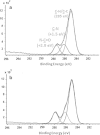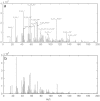ARGET-ATRP synthesis and characterization of PNIPAAm brushes for quantitative cell detachment studies
- PMID: 22589075
- PMCID: PMC3842120
- DOI: 10.1007/s13758-012-0032-z
ARGET-ATRP synthesis and characterization of PNIPAAm brushes for quantitative cell detachment studies
Abstract
Stimuli responsive (or "smart") polymer brushes represent a non-toxic approach for achieving release of biofouling layers. Thermo-responsive poly(N-isopropylacrylamide) (PNIPAAm) polymer brushes have been shown to modulate bacterial adhesion and release through transition between temperatures above and below the lower critical solution temperature (LCST ~32 °C) of PNIPAAm in water. In this article, we describe a convenient method to synthesize grafted PNIPAAm brushes over large areas for biological studies using a relatively simple and rapid method which allows atom transfer radical polymerization (ATRP) in presence of air using the activator regenerated electron transfer (ARGET) mechanism. PNIPAAm brushes were characterized using X-ray photoelectron spectroscopy, time-of-flight secondary ion mass spectroscopy, Fourier transform infrared spectroscopy, ellipsometry, and contact angle measurements. Our studies demonstrate that uniform, high purity PNIPAAm brushes with controlled and high molecular weight can be easily produced over large areas using ARGET-ATRP. We also report the use of a spinning disk apparatus to systematically and quantitatively study the detachment profiles of bacteria from PNIPAAm surfaces under a range (0-400 dyne/cm(2)) of shear stresses.
Figures





References
-
- Callow JA and Callow ME, Prog Mol Subcell Biol 42, 141 (2006). - PubMed
-
- Beer D and Stoodley P, The prokaryotes (vol 1, 3rd edn). A handbook on the biology of bacteria: symbiotic associations, biotechnology applied microbiology (Springer, Singapore, 2006).
Publication types
MeSH terms
Substances
Grants and funding
LinkOut - more resources
Full Text Sources
Other Literature Sources

